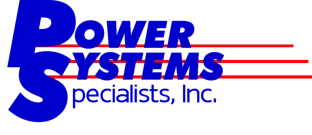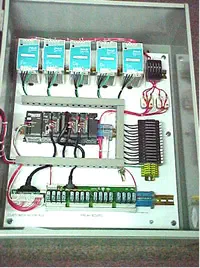
Copyright © Power Systems Specialists, Inc.
Send e-mail to: webmaster@p-s-s.com with questions or comments about site

PLC Controls
Custom control solutions can be easily incorporated into site facilities by designing a system that uses a PLC (programmable logic controller) which provides control of an Industrial / Automation Control system without having to have a whole switchboards of relays to perform the same type of operation. Whether your facility needs to: control one or several breakers, start or stop motors and pumps, interface to an existing equipment controller, control hydraulic or pneumatic solenoids, Temperature and process controls, HMI (human to machine interface) interface, PSS can design and manufacture a custom PLC Control panel that will meet and surpass your facilities needs for your Industrial/Automation Control system. A PLC is a programmable logic controller that is utilized to provide controls of system without having to have whole switchboards of relays to perform the operation. A PLC Control can be use on many different kinds of process, from robotics to simple indicator panels. The primary function of the PLC Control, depending on the set points and controls that are designed into the system will allow the PLC to automatically control the system. The operator will also be able to control the system by the use of switches, push buttons, and touchscreen panels. These devices will have an input to the PLC Control and allow the PLC to make the appropriate change to the system when the operator initiates the action. PSS incorporates the most up to date components to provide the most reliable and cost effective solution possible. In addition to using industry leading PLC components, PSS can incorporate a touch screen panel for the HMI interface or provide standard push buttons and switches with LEDs for the operation of the Control Panel. Our custom control panels have been used for: • Alarm panels for monitor building systems. • AOTS (Automatic Overlap Transfer Switch) controls for diesel generators. • Breaker controls for maintenance bypass operations for UPS systems. • Switchgear controls. • Interfaces to SCADA systems. • Industrial Process Automation Let PSS provide a custom PLC Control panel to meet your facilities requirements. The ability of our control panels to be custom designed allows our system to be used in the most effective manner for your facility. Please contact us with your requirements and we can discuss what the best design solution for your facility will be.

How a PLC Works
How a PLC works, is by using inputs and outputs to control other devices, like relays, motors, and breakers etc. These inputs and outputs can be either be a digital signal or an analog signal depending on the type of PLC control that is designed. In the PLC there is a module that is the CPU and this module has a program in it that is developed by the designer of the system with the PLC manufacture's software. This custom program is setup to read all of the inputs and to perform the necessary operations to control the outputs of the PLC to have the equipment respond in the manner the system is designed for.
Call Toll Free (888) 305-1555

PLC Controls
Custom control solutions can be easily incorporated into site facilities by designing a system that uses a PLC (programmable logic controller) which provides control of an Industrial / Automation Control system without having to have a whole switchboards of relays to perform the same type of operation. Whether your facility needs to: control one or several breakers, start or stop motors and pumps, interface to an existing equipment controller, control hydraulic or pneumatic solenoids, Temperature and process controls, HMI (human to machine interface) interface, PSS can design and manufacture a custom PLC Control panel that will meet and surpass your facilities needs for your Industrial/Automation Control system. A PLC is a programmable logic controller that is utilized to provide controls of system without having to have whole switchboards of relays to perform the operation. A PLC Control can be use on many different kinds of process, from robotics to simple indicator panels. The primary function of the PLC Control, depending on the set points and controls that are designed into the system will allow the PLC to automatically control the system. The operator will also be able to control the system by the use of switches, push buttons, and touchscreen panels. These devices will have an input to the PLC Control and allow the PLC to make the appropriate change to the system when the operator initiates the action. PSS incorporates the most up to date components to provide the most reliable and cost effective solution possible. In addition to using industry leading PLC components, PSS can incorporate a touch screen panel for the HMI interface or provide standard push buttons and switches with LEDs for the operation of the Control Panel. Our custom control panels have been used for: • Alarm panels for monitor building systems. • AOTS (Automatic Overlap Transfer Switch) controls for diesel generators. • Breaker controls for maintenance bypass operations for UPS systems. • Switchgear controls. • Interfaces to SCADA systems. • Industrial Process Automation Let PSS provide a custom PLC Control panel to meet your facilities requirements. The ability of our control panels to be custom designed allows our system to be used in the most effective manner for your facility. Please contact us with your requirements and we can discuss what the best design solution for your facility will be.

Copyright © 2002-2011 Power Systems Specialists, Inc
Send e-mail to: webmaster@p-s-s.com with questions
or comments about site

Call Toll Free (888) 305-1555
























